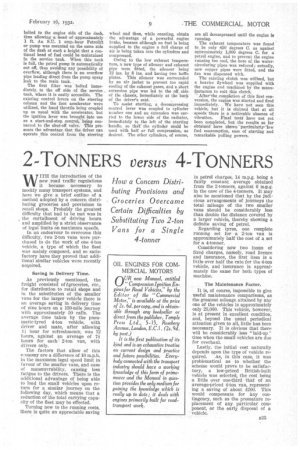2 ,-TONNERS versu s 4 -TONNERS
Page 43

If you've noticed an error in this article please click here to report it so we can fix it.
How a Concern Distributing Provisions and Groceries Overcame Certain Difficulties by Substituting Two 2-ton Vans for a Single 4-tonner
WITH the introduction of the new road traffic regulations it became necessary to modify many transport systems, and here we give a brief outline of a method adopted by a concern distributing groceries and provisions to retail shops. Probably the greatest difficulty that had to be met was in the curtailment of driving hours and amplified by a strict observance of legal limits on maximum speeds.
In an endeavour to overcome this difficulty, two 2-ton vans were purchased to do the work of one 4-ton vehicle, a type of which the fleet was mainly composed, and so satisfactory have they proved that additional similar vehicles were recently acquired.
Saving in Delivery Time.
As previously mentioned, the freight consisted Mgroceries, etc., for distribution to retail shops and in the substitution of the smaller vans for the larger vehicle there is an average saving in delivery time of nine hours on a 130-mile journey with approximately 50 calls. The average time taken by the pneumatic-tyred 4-ton vehicle, with driver and mate, after allowing 1 i hour for refreshments, was 12 hours, against an average of 7i hours for each \ 2-ton van, with drivers only.
The factors that allow of this economy are a difference of 10 m.p.h. in the maximum legal speed limit in favour of the smaller vans, and ease of manoeuvrability, causing less fatigue to the drivers. There is the additional advantage of being able to load the small vehicles upon return for a similar journey on the following day, which means that a reduction of the total carrying capacity of the fleet may be effected.
Turning now to the running costs, there is quite an appreciable saving
in petrol charges, 14 m.p.g. being a fairly constant average obtained from the 2-tonners, against 6 m.p.g. in the case of the 4-tonners. It may also be mentioned that by the judicious arrangements of journeys the total mileage of the two smaller vans Should be considerably less than double the distance covered by a larger vehicle, thereby showing a definite saving of petrol.
Regarding tyres, one complete running set for a 2-ton van is approximately half the cost of a set for a 4-tonner.
Considering now two items of fixed charges, namely, road licence and insurance, the first item is a little over half the rate for the 4-ton vehicle, and insurance is approximately the same for both types of machine.
The Maintenance Factor.
• It is, of course, impossible to give useful maintenance comparisons, as the greatest mileage attained by any one of the vehicles is approximately only 25,000. This vehicle, however, is at present in excellent condition, and, beyond the usual periodical attention given to all, little has been necessary. It is obvious that there will be considerably less "laid-up" time when the small vehicles are due for overhaul.
Lastly, the initial cost naturally depends upon the type of vehicle re
quired. As, •in this 'case, it was problematical as to whether the scheme would prove to be satisfactory, a low-priced British-built vehicle was selected, the cost being a little over one-third that of an average-priced 4-ton van, representing a saving of about f200. This would compensate for any contingency, such as the premature replacement of any particular component, or the early, disposal of a vehicle.




































































































